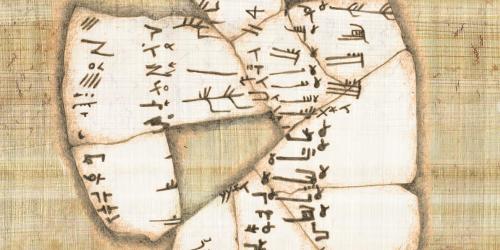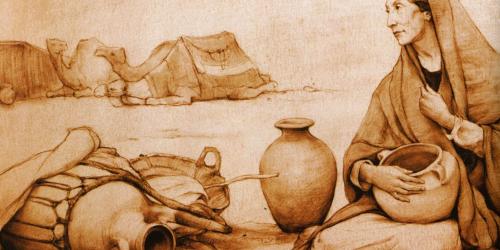You are here
Book of Mormon Central is in the process of migrating to our new Scripture Central website.
We ask for your patience during this transition. Over the coming weeks, all pages of bookofmormoncentral.org will be redirected to their corresponding page on scripturecentral.org, resulting in minimal disruption.

Scripture Block
1 Nephi 1-7
The first chapters of 1 Nephi proclaim Lehi's calling as a prophet, his family's varied responses to his message that they must leave Jerusalem, and the sons' assignments to return to Jerusalem. These chapters lay a foundation of trust in the Lord and obedience to his commands that continues throughout the Book of Mormon.
Lesson Manual
KnoWhys

Did Ancient Israelites Write in Egyptian?
1 Nephi 1:2

Did Lehi Use the Poetry of the Ancient Bedouin?
1 Nephi 2:9-10

Did Jerusalem Have Walls Around It?
1 Nephi 4:4
Featured Charts
Chart 7-94: "1 Nephi and the Exodus," from Charting the Book of Mormon
Shows parallel verses in 1 Nephi and Exodus. Lehi's group saw themselves as reenacting the exodus of the Israelites from Egypt. Just as God had called Moses and Joshua to lead the children of Israel out of oppressive conditions, across a sea and the river Jordan, and into the promised land, so he called Lehi to lead his group out of Jerusalem, across the ocean, and to a new land of promise. Nephi thought of Moses when he exhorted his brothers to be "strong like unto Moses," who had delivered his people out of captivity (1 Nephi 4:2). As a typology, that first exodus, mainly in the Old Testament book of Exodus, became a pattern whose motifs may be found throughout Nephi's story of this second exodus. It is a pattern that still holds today in the personal conversion of individuals who flee evil and seek the Lord.
Chart 9-115: "When Is It Better for One Man to Perish Than an Entire Nation?" from Charting the Book of Mormon
Ancient Israelite law authorized the slaying of a particular man at least two other times when a whole people faced destruction. This chart compares Nephi's situation with two similar incidents found in the Bible: the beheading of the rebel Sheba and the execution of King Jehoiakim.
Articles
Lehi's Call to Prophethood
"The Throne-Theophany and Prophetic Commission in 1 Nephi: A Form-Critical Analysis," by Blake T. Ostler, BYU Studies, Volume 26, no. 4
How does Lehi's call to be a prophet in 1 Nephi 1 compare with the callings of other ancient prophets? Using tools of literary and historical analysis, this article compares Lehi's vision of God seated upon his throne with the prophetic commission pattern found in several Old Testament and other ancient Israelite sources.
"The Calling of a Prophet,"(link is external) by John W. Welch, The Book of Mormon: First Nephi, the Doctrinal Foundation(link is external)
Chapter 1 of 1 Nephi reports in very brief but significant terms the essential facts about the call and public ministry of the prophet Lehi. These rich verses reward close examination. We can see Lehi's prophetic call in light of his world by inquiring how his words and experiences may have been understood by his contemporaries. It is concluded that in many remarkable respects Lehi had much in common with other prophets of God called in that classic era of ancient Israelite prophecy.
Despite the fact that the text reporting the call of Lehi is very brief, it employs several key words and images that were full of tradition and conveyed much meaning in the world in which Lehi lived. By understanding the significance of these ancient words and phrases, modern readers can appreciate many interesting aspects of Lehi's prophetic call. Especially important is Lehi's vision in which he sees God "sitting upon his throne, surrounded with numberless concourses of angels" (1 Nephi 1:8). It appears that by this experience, which compares closely with the so-called "council visions" of Old Testament prophets, Lehi became a prophet.
"Lehi and Jeremiah: Prophets, Priests, and Patriarchs,"(link is external) by David Rolph Seely and Jo Ann H. Seely, Glimpses of Lehi's Jerusalem(link is external)
"For it came to pass in the commencement of the first year of the reign of Zedekiah, king of Judah, . . . there came many prophets, prophesying unto the people that they must repent, or the great city Jerusalem must be destroyed" (1 Nephi 1:4). Thus Nephi begins his record with the call of his father Lehi to become a prophet and to join the other prophets in Jerusalem prophesying the imminent destruction of Jerusalem. Jeremiah was one of these prophets. Lehi in his brief ministry in Jerusalem would deliver the same message that Jeremiah had delivered for almost thirty years before Lehi's call, and he would suffer the same rejection and persecution. Their respective lives and records, preserved in the Book of Mormon and the Bible, richly complement each other. Lehi and Jeremiah are first and foremost prophets. They lived and ministered to their people in a pivotal time in the history of Israel. Their records are timely in that they illustrate the perils of the period that led to the disaster of Babylonian conquest and exile for Israel and the departure of Lehi's family for the promised land. At the same time their messages are timeless. Lehi and Jeremiah testified of Christ through their deeds and through their words, and both looked forward to the restoration.
"How Could Jerusalem, 'That Great City,' Be Destroyed?"(link is external) by David Rolph Seely and Fred E. Woods, Glimpses of Lehi's Jerusalem(link is external)
Nephi records that his brothers Laman and Lemuel murmured against their father Lehi "because he was a visionary man, and had led them out of the land of Jerusalem, to leave the land of their inheritance, and their gold, and their silver, and their precious things, to perish in the wilderness. And this they said he had done because of the foolish imaginations of his heart" (1 Nephi 2:11). One of the chief complaints the brothers had against their father was that they—like many—did not "believe that Jerusalem, that great city, could be destroyed according to the words of the prophets. And they were like unto the Jews who were at Jerusalem, who sought to take away the life of my father" (1 Nephi 2:13). The biblical record contains much information that helps us to better understand the attitude of Laman and Lemuel and many of their fellow inhabitants of Jerusalem and to identify the basis for their fervent belief that their city Jerusalem was invincible and impregnable.
Lehi Leaves Jerusalem
"Lehi's Altar and Sacrifice in the Wilderness," (link is external)by David Rolph Seely, Journal of Book of Mormon Studies, Volume 10, no. 1(link is external)
Lehi's building an altar raises an important issue for the reader familiar with biblical law. The Book of Mormon repeatedly assures us that the Nephites continued to live the law of Moses until the coming of Christ (2 Nephi 5:10; Jarom 1:5; Alma 30:2–3; 4 Nephi 1:12). That being the case, many readers are not surprised by Lehi's wilderness sacrifice nor by other occasions when his people "offer[ed] sacrifice and burnt offerings unto the Lord" (1 Nephi 5:9; 7:22) and built a temple, which presumably had an altar (2 Nephi 5:16; Mosiah 2:3). Yet Deuteronomy 12 appears to strictly forbid the building of altars and the making of sacrifice outside the place the Lord had chosen for that purpose. The place so designated is usually understood to be the temple in Jerusalem.
Nephi and Laban
"Nephi's Jerusalem and Laban's Sword,"(link is external) by William J. Adams Jr., Pressing Forward with the Book of Mormon(link is external)
"Sword of Laban as a Symbol of Divine Authority,"(link is external) by William J. Adams Jr., Pressing Forward with the Book of Mormon(link is external)
When Nephi returns to obtain the plates of Laban, he finds Laban unconscious in the streets of Jerusalem. One of Laban's personal possessions that greatly fascinates Nephi is Laban's sword. As a matter of fact, Nephi is so intrigued that he describes the sword explicitly in 1 Nephi 4:9 as having a blade of the most expensive steel and a hilt of well-worked gold. What were swords of Nephi's time like?
Language Studies
"Sariah in the Elephantine Papyri,"(link is external) by Jeffrey R. Chadwick, Pressing Forward with the Book of Mormon(link is external)
The name Sariah does not appear in the Bible but the name has been identified in a reconstructed form as the name of a Jewish woman living at Elephantine in Upper Egypt during the fifth century BC.
"Learning Nephi's Language: Creating a Context for 1 Nephi 1,"(link is external) by Neal Rappleye, Interpreter: A Journal of Mormon Scripture, Volume 16(link is external)
It was not long after the Book of Mormon was published before Nephi's statement that he wrote using "the learning of the Jews and the language of the Egyptians" (1 Nephi 1:2) started raising eyebrows. It has continued to perplex even the best LDS scholars, who have put forward no fewer than five different interpretations of the passage. Some have even pointed out that there seems to be no logical reason for Nephi's statement, since anyone who could read the text would know what language it was written in. I suggest that the reason the phrase has remained hard to interpret is that Nephi's statement continues to be interpreted without any context. And this is so despite the fact that Egyptian writing by Israelite scribes has been known and attested to in Nephi's very time period since at least the 1960s. Though Latter-day Saint scholars have known and written about these writings, they have generally used them just as evidence for the Book of Mormon or to bolster support for preexisting theories about Nephi's language, rather than using those texts to create a context in which Nephi's statement can be interpreted.



